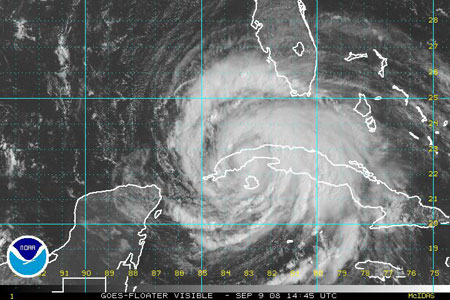Since we’ve had another bad hurricane season for the United States and the islands in the Caribbean, this topic seemed timely.

Figure 1. Hurricane Ike over Western Cuba 9 September 14:45 UTC as seen from space. Source http://www.ssd.noaa.gov/goes/flt/t4/vis-l.jpg. Ike later hit Galveston, Texas, and points northeast, causing widespread damage.
Tropical Cyclones in the United States are classified according to their wind speeds. For instance, a “Category 1″ (or Cat 1, for short) is a storm with sustained winds of 119-164 kilometers per hour (74-95 miles per hour). Yet a lot of the damage due to tropical cyclones is due to the heavy rain and storm surge as well.
What is a storm surge?
Put simply, the storm surge is the water that is blown onto the land by the wind. If you’ve watched the water level on the beach – even of a lake – you will see that the water reaches higher up the shore with onshore winds. I’ve seen this on Lake Michigan. You can make your own storm surge. Simply fill a shallow bowl or small cake pan with water, and blow across the surface of the water. The water on the opposite side of the dish becomes higher when you blow on it. (If you want to get fancy, you can even put a beach on the opposite side of the dish and see how hard you have to blow to cover it up with water. Maybe you can even get a friend to help.)
Storm surges are worse when the tides are high, because there is more water to work with. It’s like filling up your shallow bowl a little bit more.
Wind Damage.
The force due to wind increase as the square of the wind speed (wind speed times wind speed). So a 4 meter-per-second wind (8 miles per hour) will exert 16 times as much force on a tree, house, or you compared to a 1-meter-per-second wind. I’m told that the damage from a hurricane is a function of the “work” done by the wind – and that goes as the cube of the wind speed. In this case, a 4 meter-per-second wind will cause 64 times as much damage as a 1 meter-per-second wind. Again – this is just a rough estimate. The way the wind behaves – its steadiness or gustiness and its direction relative to a structure – will also affect damage patterns.
You can get a pretty good idea of the wind speed – at least for lighter winds – by watching the effects of wind on trees, smoke, and other things. Those of you interested in trying this should go to http://www.ncdc.noaa.gov/oa/climate/conversion//beaufortland.html to get a complete chart.
The force also increases with the density of the air. One thing I was curious about was whether the rainfall also helped to push you (or a building) over in stronger winds. It turns out that the extra force due to the rain is not very big. The largest rainfall rate I could find was 304.8 mm in 42 minutes (Locatelli and Hobbs, Weather and Forecasting, 2005), and that is equivalent to about 15.1 grams of water in a cubic meter of air. Since air has a mass of about 1.2 kilograms per cubic meter, the raindrops increase the density by around 1.2 per cent. Not much at all!
Of course rainfall may have other effects, like weakening some structures or changing the way they interact with the wind.
Water Damage
Rain also leads to flooding. Slow-moving tropical cyclones like Hurricane Fay, which recently hit Florida, can dump lots of water onto land, creating widespread flooding. Rainfall totals from Fay reached around 700 millimeters in a few days.
Tornado Damage
If you want to make a tornado, you need to have (1) “unstable” air – (This simply means that the temperature and humidity of the air make it easy for strong updrafts to develop.) and (2) wind change with height. Hurricanes have both. So, many hurricanes lead to tornado outbreaks. Fortunately, the tornadoes tend to be weaker than those associated with severe thunderstorms in the U.S.
For storms like hurricanes and tornadoes, it is important to know the rules for being safe. Also, keep close track of updates when severe weather threatens.
